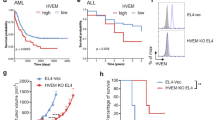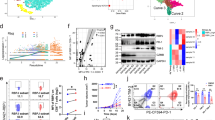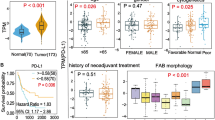Abstract
Anti-PD-1 immunotherapy has been widely applied in patients with some types of lymphoma. Classical Hodgkin’s lymphoma (cHL) is highly sensitive to immunotherapy, but non-Hodgkin’s lymphoma (NHL) does not show a good response. Studies have indicated that haematopoietic progenitor kinase 1 (HPK1) suppresses T cells and reduces antitumour immunity. Therefore, HPK1 inhibitors may restore and elicit antitumour immune responses and are promising candidate drug targets for cancer immunotherapy. We first explored the Gene Expression Profile Interactive Analysis (GEPIA) database and predicted that HPK1 expression was increased in diffuse large B-cell lymphoma (DLBCL) and associated with Nod-like receptor protein 3 (NLRP3) expression. We investigated whether an HPK1 inhibitor could enhance the tumour response to anti-PD-1 immunotherapy in NHL and the association between HPK1 and NLRP3 expression. Employing shHPK1 and an inhibitor, we demonstrated that the HPK1 inhibitor increased anti-PD-1-mediated T-cell cytotoxicity in BJAB and WSU-DLCL2 cells cocultured with peripheral blood mononuclear cells (PBMCs). HPK1 inhibitor treatment increased PD-1, PD-L1, Bax, p53 and NK-kB expression but decreased NLRP3 expression, indicating that the HPK1 inhibitor promoted apoptosis and blocked the NLRP3 inflammasome pathway to affect anti-PD-1-mediated T-cell cytotoxicity. Moreover, the HPK1 inhibitor enhanced the efficiency of anti-PD-1 immunotherapy in vivo in a zebrafish xenograft model of NHL. In summary, this study provides evidence that an HPK1 inhibitor enhanced the tumour response to anti-PD-1 immunotherapy in NHL by promoting apoptosis and blocking the NLRP3 pathway. These findings provide a potential therapeutic option for NHL combining HPK1 inhibitor treatment and anti-PD-1 immunotherapy.







Similar content being viewed by others
Data availability
Anonymized data are available upon request to the corresponding author.
References
Zhang H, Dai Z, Wu W, et al. Regulatory mechanisms of immune checkpoints PD-L1 and CTLA-4 in cancer. J Exp Clin Cancer Res. 2021;40:184. https://doi.org/10.1186/s13046-021-01987-7.
Sharpe AH, Pauken KE. The diverse functions of the PD1 inhibitory pathway. Nat Rev Immunol. 2018;18:153–67. https://doi.org/10.1038/nri.2017.108.
Xu-Monette ZY, Zhou J, Young KH. PD-1 expression and clinical PD-1 blockade in B-cell lymphomas. Blood. 2018;131:68–83. https://doi.org/10.1182/blood-2017-07-740993.
Ansell SM, Lesokhin AM, Borrello I, et al. PD-1 blockade with nivolumab in relapsed or refractory Hodgkin’s lymphoma. N Engl J Med. 2015;372:311–9. https://doi.org/10.1056/NEJMoa1411087.
Andorsky DJ, Yamada RE, Said J, et al. Programmed death ligand 1 is expressed by non-hodgkin lymphomas and inhibits the activity of tumor-associated T cells. Clin Cancer Res. 2011;17:4232–44. https://doi.org/10.1158/1078-0432.CCR-10-2660.
Chen BJ, Chapuy B, Ouyang J, et al. PD-L1 expression is characteristic of a subset of aggressive B-cell lymphomas and virus-associated malignancies. Clin Cancer Res. 2013;19:3462–73. https://doi.org/10.1158/1078-0432.CCR-13-0855.
Sawasdikosol S, Zha R, Fisher TS, et al. HPK1 Influences Regulatory T Cell Functions. Immunohorizons. 2020;4:382–91. https://doi.org/10.4049/immunohorizons.1900053.
Sawasdikosol S, Burakoff S. A perspective on HPK1 as a novel immuno-oncology drug target. Elife. 2020. https://doi.org/10.7554/eLife.55122.
Shui JW, Boomer JS, Han J, et al. Hematopoietic progenitor kinase 1 negatively regulates T cell receptor signaling and T cell-mediated immune responses. Nat Immunol. 2007;8:84–91. https://doi.org/10.1038/ni1416.
Hernandez S, Qing J, Thibodeau RH, et al. The kinase activity of hematopoietic progenitor kinase 1 is essential for the regulation of T cell function. Cell Rep. 2018;25:80–94. https://doi.org/10.1016/j.celrep.2018.09.012.
You D, Hillerman S, Locke G, et al. Enhanced antitumor immunity by a novel small molecule HPK1 inhibitor. J Immunother Cancer. 2021. https://doi.org/10.1136/jitc-2020-001402.
Greten FR, Grivennikov SI. Inflammation and cancer: triggers, mechanisms, and consequences. Immunity. 2019;51:27–41. https://doi.org/10.1016/j.immuni.2019.06.025.
Schroder K, Tschopp J. The inflammasomes. Cell. 2010;140:821–32. https://doi.org/10.1016/j.cell.2010.01.040.
Theivanthiran B, Evans KS, DeVito NC, et al. A tumor-intrinsic PD-L1/NLRP3 inflammasome signaling pathway drives resistance to anti-PD-1 immunotherapy. J Clin Invest. 2020;130:2570–86. https://doi.org/10.1172/JCI133055.
Lu F, Zhao Y, Pang Y, et al. NLRP3 inflammasome upregulates PD-L1 expression and contributes to immune suppression in lymphoma. Cancer Lett. 2021;497:178–89. https://doi.org/10.1016/j.canlet.2020.10.024.
**e W, Medeiros LJ, Li S, et al. PD-1/PD-L1 pathway and its blockade in patients with classic hodgkin lymphoma and non-hodgkin large-cell lymphomas. Curr Hematol Malig Rep. 2020;15:372–81. https://doi.org/10.1007/s11899-020-00589-y.
Kuzume A, Chi S, Yamauchi N, et al. Immune-Checkpoint Blockade Therapy in Lymphoma. Int J Mol Sci. 2020. https://doi.org/10.3390/ijms21155456.
Zitvogel L, Kepp O, Galluzzi L, et al. Inflammasomes in carcinogenesis and anticancer immune responses. Nat Immunol. 2012;13:343–51. https://doi.org/10.1038/ni.2224.
Karki R, Kanneganti TD. Diverging inflammasome signals in tumorigenesis and potential targeting. Nat Rev Cancer. 2019;19:197–214. https://doi.org/10.1038/s41568-019-0123-y.
Si J, Shi X, Sun S, et al. Hematopoietic progenitor kinase1 (HPK1) mediates T cell dysfunction and is a druggable target for T cell-based immunotherapies. Cancer Cell. 2020;38:551–66. https://doi.org/10.1016/j.ccell.2020.08.001.
Liu C, Liu R, Wang B, et al. Blocking IL-17A enhances tumor response to anti-PD-1 immunotherapy in microsatellite stable colorectal cancer. J Immunother Cancer. 2021. https://doi.org/10.1136/jitc-2020-001895.
Khalil DN, Smith EL, Brentjens RJ, et al. The future of cancer treatment: immunomodulation, CARs and combination immunotherapy. Nat Rev Clin Oncol. 2016;13:273–90. https://doi.org/10.1038/nrclinonc.2016.25.
Wang Y, Zhang K, Georgiev P, et al. Pharmacological inhibition of hematopoietic progenitor kinase 1 positively regulates T-cell function. PLoS One. 2020;15:0243145. https://doi.org/10.1371/journal.pone.0243145.
Linney ID, Kaila N. Inhibitors of immuno-oncology target HPK1––a patent review (2016 to 2020). Expert Opin Ther Pat. 2021;31:893–910. https://doi.org/10.1080/13543776.2021.1924671.
Funding
This study was supported by Fujian Provincial Health Technology Project (Grant No. 2022CXA027), the Natural Science Foundation of Fujian Province (Grant No. 2020J011117), the Joint Funds for the Innovation of Science and Technology, Fujian Province (Grant No. 2019Y9040).
Author information
Authors and Affiliations
Contributions
LY designed the study and wrote the main manuscript. QLZ and TC performed methodology and statistical analysis while WBL and XLQ wrote the original draft. JCC performed methodology. SQH performed the visualization and validation. RYH, LLD performed the modification.
Corresponding author
Ethics declarations
Conflict of interests
The authors declare that they have no conflict of interests.
Additional information
Publisher's Note
Springer Nature remains neutral with regard to jurisdictional claims in published maps and institutional affiliations.
Supplementary Information
Below is the link to the electronic supplementary material.
10238_2023_1068_MOESM1_ESM.tif
Fig. S1 GEPIA dataset predicted the gene expression profile of HPK1. (A) The gene expression profile across all tumor samples and paired normal tissues. (B) The Box Plots the expression of HPK1 in DLBCL and control samples. (C) The overall survival profile of HPK1 level expression in DLBCL and control samples. (D) Correlation analysis for HPK1 and NLRP3 in DLBCL tumor datasets.
10238_2023_1068_MOESM2_ESM.tif
Fig. S2 The CD8(+) T cell number was measured by flow cytometry in BJAB(A) and WSU-DLCL2(B) cells co-cultured with PBMCs and with anti-PD-1 treatment.
10238_2023_1068_MOESM3_ESM.tif
Fig. S3 An HPK1 inhibitor enhanced anti-PD-1 mediated T cell cytotoxicity and apoptosis in WSU-DLCL2 cells. (A) The effect of shHPK1 or GNE-1858 treatment on the proliferation of WSU-DLCL2 cells cocultured with PBMCs after 24 h, 48 h, and 72 h of anti-PD-1 treatment was detected by CCK8 assay. (B) The effect of shHPK1 or GNE-1858 treatment on the proliferation of WSU-DLCL2 cells cocultured with PBMCs after 24 h, 48 h, and 72 h of anti-PD-1 treatment was detected by soft agar colony-formation assay. (C) The effect of shHPK1 or HPK1 inhibitor GNE-1858 treatment on the survival of WSU-DLCL2 cells co-cultured with PBMCs after 3d, 7d and 10d anti-PD-1 treatment was detected with a counter. (D) The effect of shHPK1 or HPK1 inhibitor GNE-1858 treatment on the apoptotic rate of WSU-DLCL2 cells cocultured with PBMCs 72 h of anti-PD-1 treatment was detected by flow cytometry.
10238_2023_1068_MOESM4_ESM.tif
Fig. S4 HPK1 inhibitor treatment affected apoptosis (Bax, p53) and the inflammasome (NLRP3) pathway in WSU-DLCL2 cells.Western blotting was performed to detect the indicated protein levels upon treatment with shHPK1 (A) or an HPK1 inhibitor (B) in WSU-DLCL2 cells cocultured with PBMCs treated with anti-PD-1, and the results were quantified. Gels/blots cropped from different gels are grouped.
Rights and permissions
Springer Nature or its licensor (e.g. a society or other partner) holds exclusive rights to this article under a publishing agreement with the author(s) or other rightsholder(s); author self-archiving of the accepted manuscript version of this article is solely governed by the terms of such publishing agreement and applicable law.
About this article
Cite this article
Yang, L., Zhao, Q., Chen, T. et al. An HPK1 inhibitor enhanced the tumour response to anti-PD-1 immunotherapy in non-Hodgkin’s lymphoma. Clin Exp Med 23, 3767–3780 (2023). https://doi.org/10.1007/s10238-023-01068-3
Received:
Accepted:
Published:
Issue Date:
DOI: https://doi.org/10.1007/s10238-023-01068-3




